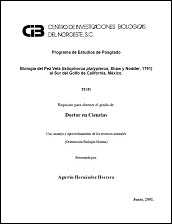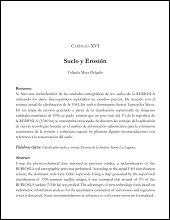Balance de nutrientes y respuesta Productiva de Litopenaeus vannamei en Mesocosmos con cero recambio de agua y Sustratos artificiales
Resumen
Litopenaeus vannamei juveniles were grown in 1000 L circular tanks in two separate 30 days experiments with zero water exchange, aiming to evaluate the effect of artificial substrates on the nutrient mass budgets, on water quality, as well as on growth, biomass yields and nutritional condition. For the first experiment we used a simple experimental design with an initial biomass of 440 g, and compared the results obtained in four tanks fed a formulated diet supplied on demand, to those of four similar cultures fed with the same diet and regime, but with the added natural food growing on artificial substrates (Aquamats). For the second experiment we used the same treatments in a 2x2 completely randomized block experimental design, with two levels of initial biomass (600 y 800 g). The production variables were better in the treatments than in the control cultures in both experiments: in the first, individual weight, final yield and survival were 4.3, 13.0 and 8.5% higher in the cultures with added substrate than in the controls, and the food and economic conversion ratios were also better by 17.8 and 22.2%, respectively. At the end of the second experiment the differences were significantly higher with both values of initial biomass: final weights were better by 12.6 and 19.7%, biomass yields by 29.9 and 42.3%, and survival by 15.1 and 22.0%. In addition, the food and economic conversion ratios were lower by close to 32.0 y 43.0%. There were no differences between the protein concentrations of the hemolymph, whereas the protein content of the shrimp muscles were close to 21% higher in the cultures with Aquamats. Additionally, the water of the cultures with Aquamats had the lower concentrations of dissolved ammonia nitrogen. Se realizaron dos experimentos de cultivo con el fin de evaluar el efecto de sustratos artificiales sobre el balance de masas de nutrientes, la calidad del agua, el crecimiento, la producción y la condición nutricional de juveniles de L. vannamei, confinados en tanques circulares de 1000 L, con duración de 30 días cada uno y sin recambio de agua. En el primer experimento se utilizó un diseño experimental simple, con biomasa inicial de 440 g, comparando el desempeño de cuatro cultivos que recibieron alimento balanceado suministrado según demanda, con el que se obtuvo en cuatro cultivos similares y con el mismo alimento, además de la productividad natural de la biopelícula establecida en sustratos artificiales (Aquamats). En el segundo experimento se empleó un diseño factorial por bloques completamente aleatorizado 2x2, contrastando los mismos tratamientos de alimentación, en presencia o ausencia de sustrato artificial, pero en cultivos con 600 y 800 g de biomasa inicial. En el primer experimento, el peso individual, la biomasa y la supervivencia final del tratamiento con incremento de sustrato superaron en 4.3, 13.0 y 8.5% los valores registrados en los cultivos control y además resultaron 17.8 y 22.2% mejores los valores medios de los factores de conversión alimenticia y económica, respectivamente (P<0.05). En el segundo experimento las diferencias resultaron más importantes con ambos niveles de biomasa: los pesos fueron superiores en 12.6 y 19.7%, la biomasa en 29.9 y 42.3%, la supervivencia en 15.1 y 22.0%, asimismo la conversión alimenticia y económica fueron cerca del 32.0 y 43.0% menores, respectivamente. No se observaron diferencias en los niveles de proteína en la hemolinfa, sin embargo el contenido de proteína en el músculo fue cerca del 21% mayor en los tratamientos con respecto a los controles. Además, en este segundo experimento la concentración de nitrógeno amoniacal resultó significativamente menor en los cultivos con Aquamats (0.51±0.03 y 0.05±0.01 mg L-1) respecto a los controles (0.80±0.01 y 1.28±0.01 mg L-1, correspondientemente). En el balance de masas de nutrientes el alimento balanceado representó el ingreso principal de nitrógeno y fósforo.
Colecciones
Ítems relacionados
Mostrando ítems relacionados por Título, autor o materia.
-
PROMOCIÓN DEL PERIFITON PARA EL CULTIVO DE CAMARÓN BLANCO: HACIA UNA ACUICULTURA ECOLÓGICA
DOMENICO VOLTOLINA LOBINA; JUAN MANUEL AUDELO NARANJO; MARIA DEL ROSARIO PACHECO MARGES -
Suelo y Erosión
YOLANDA LOURDES MAYA DELGADO


